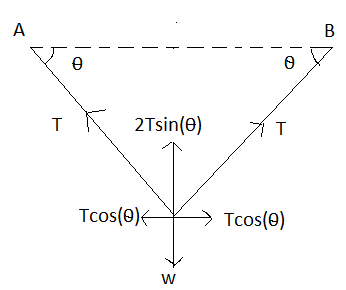
A weight \[\omega \;\] is suspended from the midpoint of a rope, whose ends are at the same level. In order to make the rope perfectly horizontal, the force applied to each of its ends must be
(A) Less than \[\omega \;\]
(B) Equal to \[\omega \;\]
(C) Equal to \[2\omega \;\]
(D) Infinitely large
Answer
220.8k+ views
Hint: We draw the free body diagram of the following system to solve this question. We find the sum of forces acting upwards and downwards and equate them since there is horizontal force. Both the horizontal components of the two sides of the string get cancelled. So, the weight acting downwards is equal to the sum of upward forces.
The angle between the string and the x-axis should be zero for the body to be horizontal. Substituting this condition in the final equation we get the answer.
Complete step by step solution: The free body diagram of the system is

The weight is at the centre of the string so the tension is distributed equally on both sides of the string. The tension force on both the sides of the string is resolved into
$T = Tcos\theta + T\sin \theta $
As shown in the diagram
The horizontal components are equal and opposite in direction so they get cancelled.
$Tcos\theta - Tcos\theta = 0$
Since the body is at equilibrium the sum of upwards forces is equal to downwards force (weight of the body)
Forces acting upwards are the vertical components of the tension force
$T\sin \theta + T\sin \theta = 2T\sin \theta $
Weight of the body is $\omega \ $
Upward force is equal to downwards force
$\omega \ = 2T\sin \theta $
For the rope to be perfectly horizontal $\theta $ should be $0^\circ $
Substituting $\theta = 0^\circ $
$ \omega \ = 2T\sin \theta $
$ \omega \ = 2T\sin 0^\circ $
$ T = \dfrac{{\omega \ }}{{2\sin 0^\circ }} = \dfrac{{\omega \ }}{0} $
Anything by zero is infinite
Hence the force applied on each end should be infinitely large.
Option (D) infinitely large is the correct answer.
Note: The angle $\theta $ is also equal to the angle between the tension force and the Horizontal which is the reason we can resolve the tension force with angle $\theta $
Students might go wrong by taking tensions in the two sides of the string with different values. The tension remains the same on both the sides because the weight is being suspended from the center.
The angle between the string and the x-axis should be zero for the body to be horizontal. Substituting this condition in the final equation we get the answer.
Complete step by step solution: The free body diagram of the system is

The weight is at the centre of the string so the tension is distributed equally on both sides of the string. The tension force on both the sides of the string is resolved into
$T = Tcos\theta + T\sin \theta $
As shown in the diagram
The horizontal components are equal and opposite in direction so they get cancelled.
$Tcos\theta - Tcos\theta = 0$
Since the body is at equilibrium the sum of upwards forces is equal to downwards force (weight of the body)
Forces acting upwards are the vertical components of the tension force
$T\sin \theta + T\sin \theta = 2T\sin \theta $
Weight of the body is $\omega \ $
Upward force is equal to downwards force
$\omega \ = 2T\sin \theta $
For the rope to be perfectly horizontal $\theta $ should be $0^\circ $
Substituting $\theta = 0^\circ $
$ \omega \ = 2T\sin \theta $
$ \omega \ = 2T\sin 0^\circ $
$ T = \dfrac{{\omega \ }}{{2\sin 0^\circ }} = \dfrac{{\omega \ }}{0} $
Anything by zero is infinite
Hence the force applied on each end should be infinitely large.
Option (D) infinitely large is the correct answer.
Note: The angle $\theta $ is also equal to the angle between the tension force and the Horizontal which is the reason we can resolve the tension force with angle $\theta $
Students might go wrong by taking tensions in the two sides of the string with different values. The tension remains the same on both the sides because the weight is being suspended from the center.
Recently Updated Pages
Two discs which are rotating about their respective class 11 physics JEE_Main

A ladder rests against a frictionless vertical wall class 11 physics JEE_Main

Two simple pendulums of lengths 1 m and 16 m respectively class 11 physics JEE_Main

The slopes of isothermal and adiabatic curves are related class 11 physics JEE_Main

A trolly falling freely on an inclined plane as shown class 11 physics JEE_Main

The masses M1 and M2M2 M1 are released from rest Using class 11 physics JEE_Main

Trending doubts
JEE Main 2026: Application Form Open, Exam Dates, Syllabus, Eligibility & Question Papers

Understanding Uniform Acceleration in Physics

Derivation of Equation of Trajectory Explained for Students

Hybridisation in Chemistry – Concept, Types & Applications

Understanding the Angle of Deviation in a Prism

How to Convert a Galvanometer into an Ammeter or Voltmeter

Other Pages
Thermodynamics Class 11 Physics Chapter 11 CBSE Notes - 2025-26

JEE Advanced Marks vs Ranks 2025: Understanding Category-wise Qualifying Marks and Previous Year Cut-offs

Units And Measurements Class 11 Physics Chapter 1 CBSE Notes - 2025-26

NCERT Solutions For Class 11 Physics Chapter 8 Mechanical Properties Of Solids

Motion in a Straight Line Class 11 Physics Chapter 2 CBSE Notes - 2025-26

Laws of Motion Class 11 Physics Chapter 4 CBSE Notes - 2025-26




